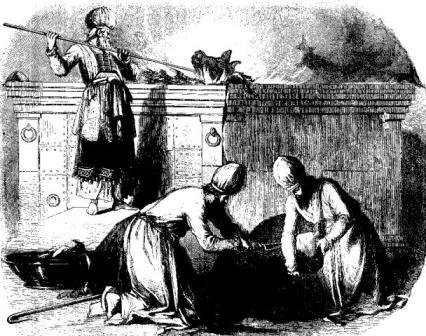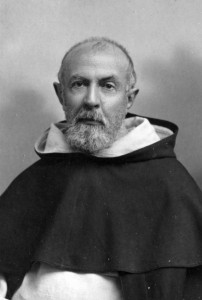In June of 1909, the pope himself dismissed a priest from teaching Scripture at the Catholic University of America. The firing came in the wake of the Modernist crisis, the decision of the Pontifical Biblical Commission (PBC) which upheld Mosaic authorship of the Pentateuch (June 27, 1906) the publication of Lamentabili (a. k. a., The Syllabus of Errors, July 3, 1907) and the encyclical Pascendi Dominici Gregis (Sep 8, 1907).
Henry Poels was a Dutchman and he had been hired by CUA in 1904 to teach Old Testament. At this time, Charles P. Grannan was dean of the School of Theology and Daniel J. O’Connell was the rector of the University. There was some initial confusion over Poels’ status in the university. Grannan and the faculty supported him while O’Connell was skeptical of his leanings. It seems that Grannan and O’Connell were often at loggerheads.
Poels was a consultor to the PBC when it issued its decision on Mosaic authorship. The PBC was Leo XIII’s brainchild. As an arm of the magisterium, its purpose was to establish official Church positions on biblical topics. It only promulgated a few official decisions in its early history and these have resulted in some controversy, which I have written about here on this blog. The text of the PBC’s decision from June 27, 1906 can be found online in English and Latin. It basically rejects the idea that Moses did not write the Pentateuch, accepts the possibility that Moses may have used assistants to write it, grants that he may have used prior sources, and affirms the critical study of textual problems.
Fr. Poels planned to teach a class on “Hebrew Institutions, as seen in Law and History” in the Fall 1906. But after the PBC’s decision he thought he could not teach the course in good conscience, so he offered a course on “the Biblical Question” instead (Poels 14-15). Why? Well, he differed from the PBC. Poels states his position thus:
- I could not and cannot conscientiously teach that Moses was the actual author of the first five books of the Bible, as we have them to-day. In this view I do not stand alone, for, as a matter of fact, the overwhelming majority of Old Testament scholars–yea, practically all the Old Testament critics, of any name, are agreed on this point (Poels 15).
Poels found himself in an odd situation. Being a man of honor, he could not “follow the policy of other Catholic Professors…who, thinking as I did, continued their professional duties” (Poels 15). He wanted affirmation. If he had let the issue lie, mostly likely nothing would have happened. But he wanted to make sure he was in a good place and so his troubles began.
He visited Rome in the summer of 1907 to find the affirmation he was looking for. He met with Cardinal Satolli and asked if his disposition would be acceptable if he held that “generally speaking, the institutions, mentioned in the Pentateuch, were of Mosaic origin, although the documents in which these institutions are described, and in their present literary form, did not all actually come from the pen of Moses” (Poels 16). Satolli deferred judgment, so Poels met with Pope Pius X himself.
Poels described his situation to the pope. He related that the question of Mosaic authorship has bearing on every dimension of Old Testament study. The pope acknowledged that according to natural law, he must obey his conscience, but according to church law, he must obey the PBC. So the pope suggested Poels teach in another area. His companion and interpreter, Fr. Genocchi suggested that this would be inappropriate since university professors should be specialists in their area. Pius X then directed Poels to follow the advice of Fr. Genocchi and Fr. Janssens. (Janssens was the head of the PBC.)
Poels was a bit confused. He felt he ought to teach in another field, but Genocchi and Janssens urged him to hold his post as an Old Testament professor at CUA. Poels accepted their advice, but asked that they would inform the pope. Both Genocchi and Janssens had audiences with the pope and informed him of the advice. Poels was apparently a bit nervous about the whole thing, so he wrote Genocchi whose reply did not satisfy him. Then he wrote Janssens to ask him to confirm that the pope was privy to the advice for Poels to retain his chair. Janssens met with the pope and “talked over your case a long time quite alone with the Pope” (Poels 49). Janssens states that, as long as Poels would show no contempt for the PBC and its decisions, “the Pope permits you to retain your professional chair.” Additionally, the pope said “Tell him that I send to him with love my fatherly blessing” (Poels 49). At this point in May of 1908, it seemed the whole question was resolved and Poels could finally sleep well at night.
But as history would have it, confusion ensues, many more characters get involved and the Rev. Dr. Henry Poels would have many more sleepless nights. However, the rest of the story will have to wait for another post.
———
Sources on Henry Poels:
Ellis, John Tracy. The Life of Cardinal Gibbons. Vol. 2. Milwaukee: Bruce, 1952. pp.171-182.
Fogarty, Gerald P. American Catholic Biblical Scholarship: A History From The Early Republic To Vatican II. San Francisco: Harper and Row, 1989. pp. 78-119.
Poels, Henry A. A Vindication of My Honor. Leuven: University Press: Peeters, 1982


